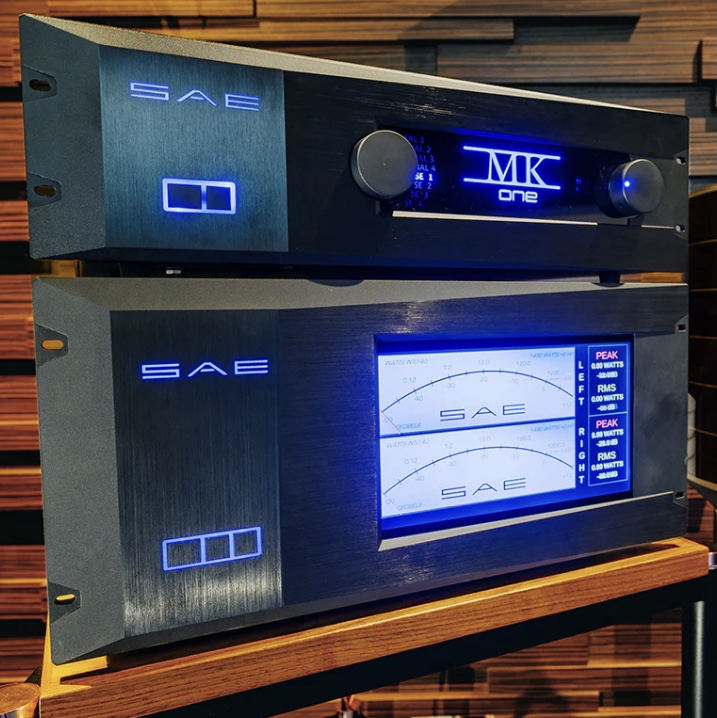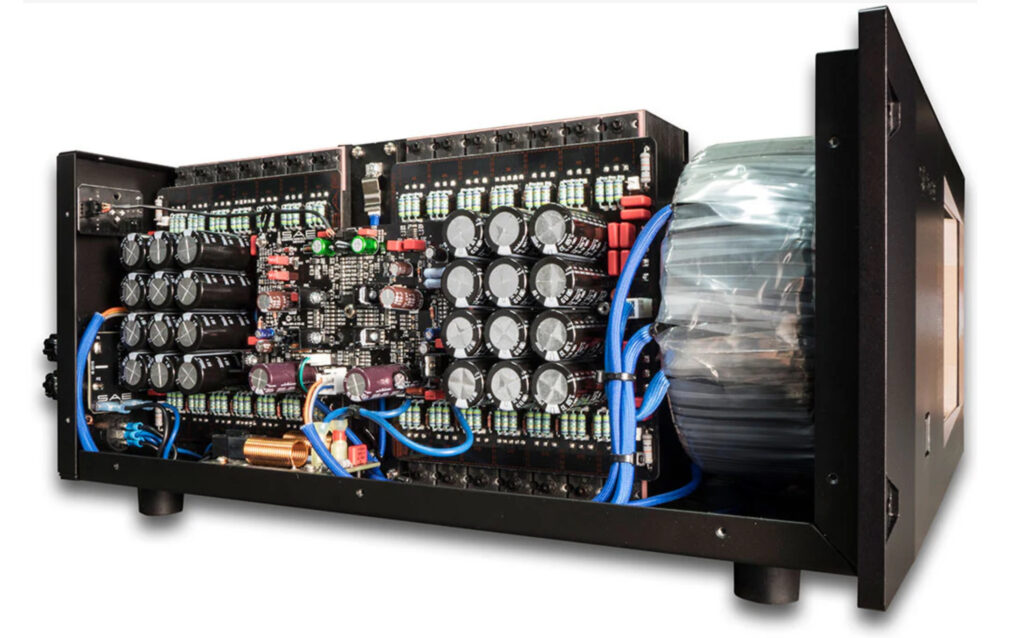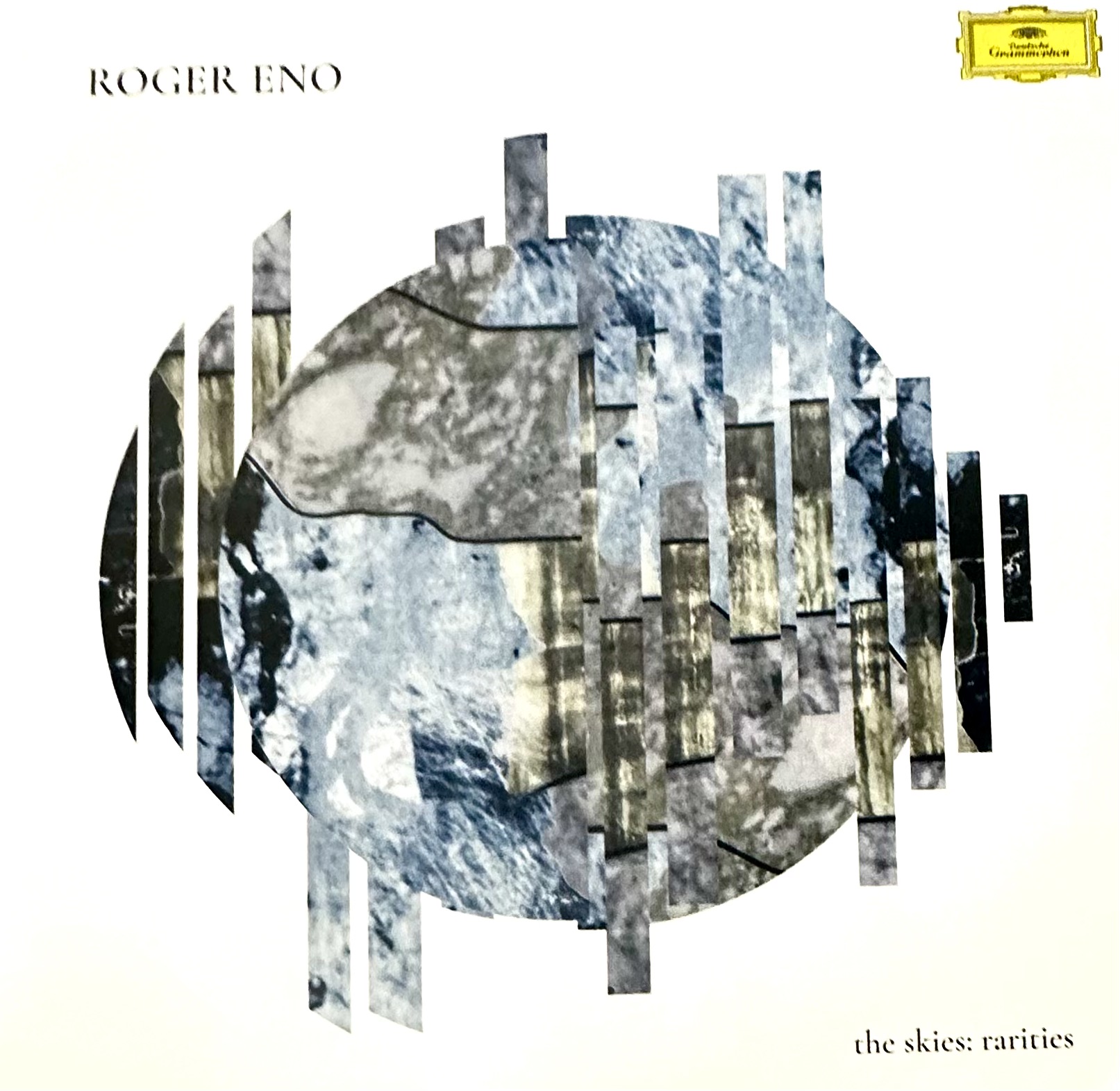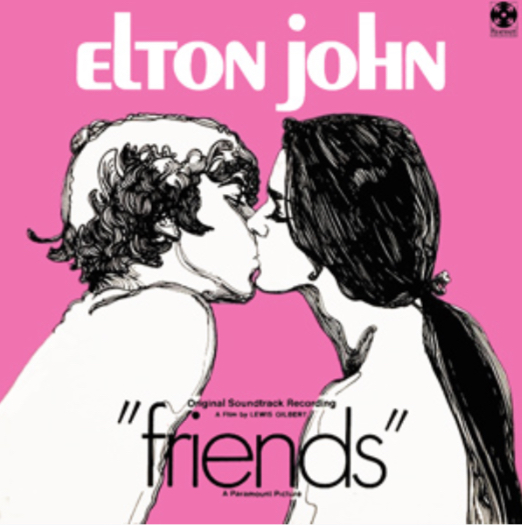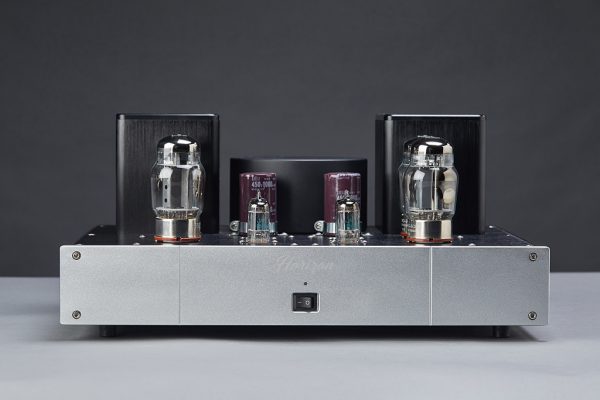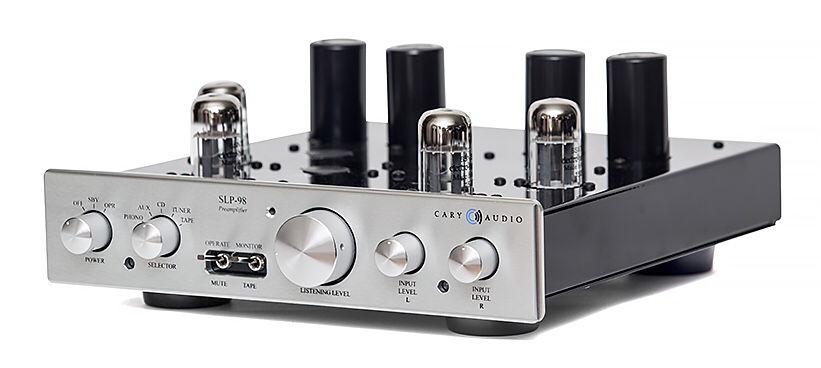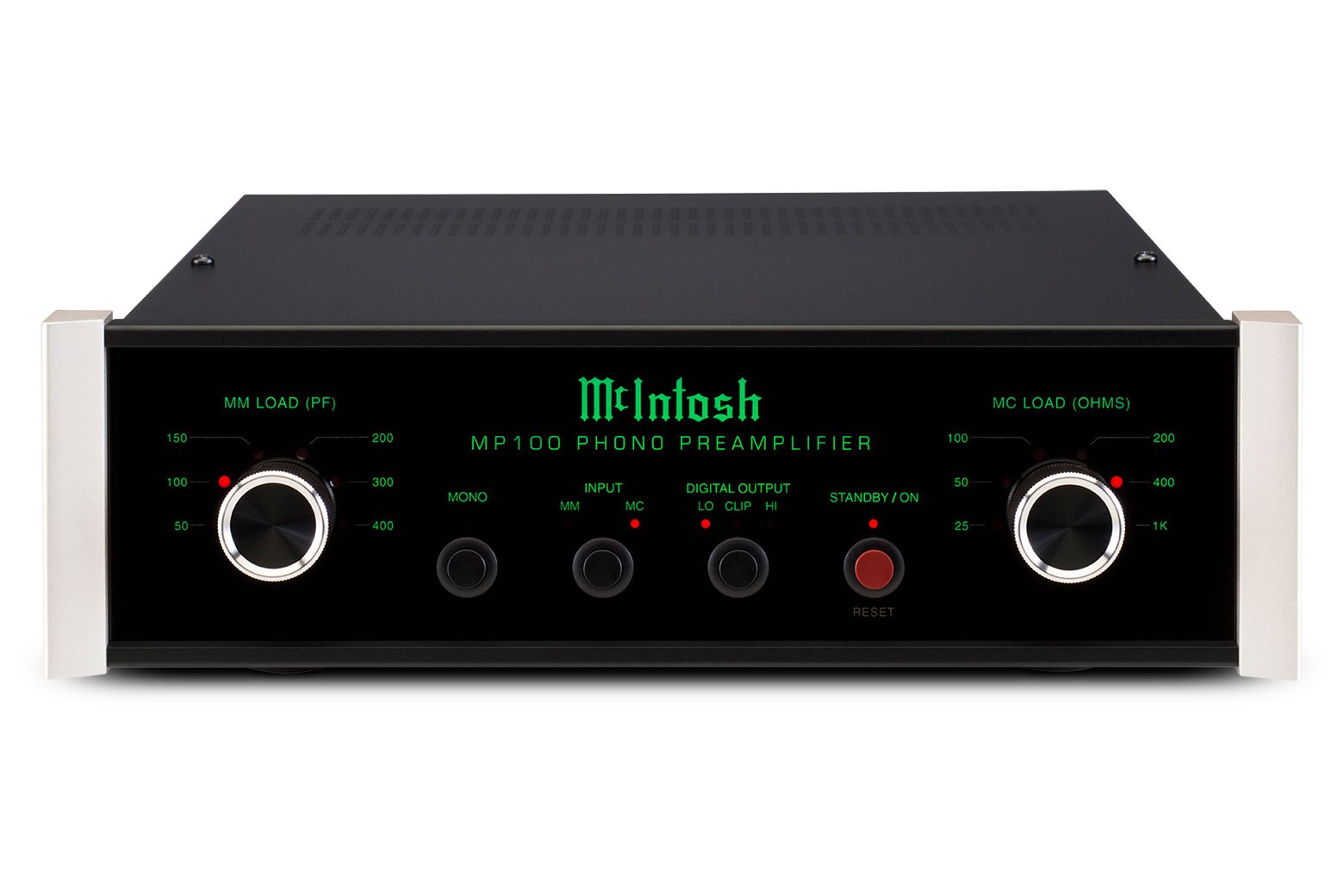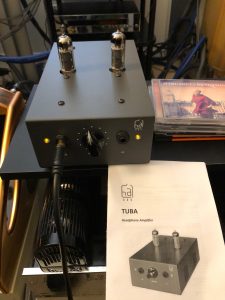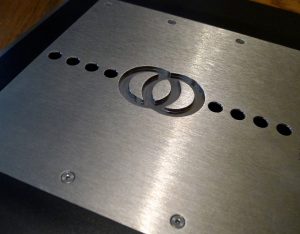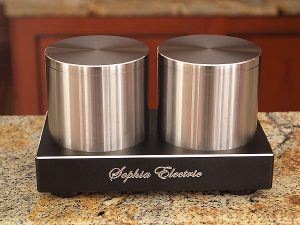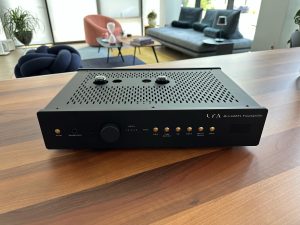Fifty years ago SAE hit the market with its first amplifier, the venerable MK 1. A 60-watt per channel affair that stunned the audio world and received rave reviews by none other than J. Gordon Holt when he stated that under most conditions it was the best sounding solid-state gear he had ever heard. Big praise to be sure. It rocked the audio world. (Intended double entendres.)
Here we are 50 years on, and again we have a new and improved amplifier and matching preamp. The opportunity to review this pair was a like a siren's song to a sailor. It was an incredible and enticing proposition. So let us delve into this Duo and see if it measured up to the dream or not. Spoiler alert. This Duo was meant to be reviewed as a system, so while I will make comments on each, the listening sessions and notes were done as a system and not separately. I will also refer to them as the "Duo."
I am, by and large, a unapologetic fan of tube driven components, especially in terms of amps and preamps. The chance to spend significant time with a full solid-state setup was something I rarely get to do. Solid-state has come a long way since my initial foray into high end audio some 50 years ago.
I had also come a long way in my knowledge of the gear and the development of my own views on what floated my boat. Solid-state came and went in my system in various configurations over the years but ultimately I found myself settling on tubes and the sound they provide created the best system for my ears. I was all a tither with excitement to see what this Duo would bring.
A few weeks after the initial discussion, a delivery company arrived at my home and delivered the SAE Duo. When they arrived I was anxious to unbox the gear and get going.
Both pieces have face plates that are rack compatible, and are available in either black or silver finish. These are actually quite beautiful units. The review samples were in black, and after staring at them daily for six weeks I can say that the black would be the definitive color choice for me as it facilitates an extra pop of the meters and the blue lit controls. They are quite simply stunning and elegant without being fussy or too busy.
The HP2-D Dual Mono Amplifier
First thing you should know is you actually do need two strong people to deal with unboxing and placing the 2HP-D amplifier. To say it is a heavy beast may be a bit of an understatement. Weighing in at 127 lbs. it is not something that lends itself to easily moving about. It was placed in between my existing amps on a spiked marble slab about two inches above the floor, and there it stayed until it was time to return the unit. I highly encourage you, if you are to purchase them and are not built like a young Arnold Schwarzenegger, to seek assistance. I am fortunate I have good friends who always willing to help.
The boxing is superb and well packed. Once you place the HP2-D you can begin working on getting it properly hooked up to the MK One.
This is essentially two amplifiers in one cabinet. It requires separate power cords for right and left channels. When looking into the amp (I used SAE photos because I really don't like opening up pieces that are not mine) it is easy to see the side by side but distinctly independent amplifiers in tandem.
The front panel is graced by two very large and entertaining video meters that take up the bulk of the face plate, plus two control buttons. These are not just pretty additions, but rather very comprehensive VU meters that give you very real and useful info. The VU meters are the brainchild Morris Kessler, noted audio engineer and co-founder of the company. He enlisted two other noteworthy engineers to help create the monster that we are examining here. James Bongiorno and Jerry Curtis were also instrumental in the development of this piece. The design brief was simple and straightforward. Immense power, dead quiet, virtual VU meters, advanced balanced topology with current feedback, and a dual mono design. No worries!
"The SAE 2HP-D includes another SAE innovation. A remarkable digital display that offers hyper-accurate real-time information. In order to keep pace with the speed and responsiveness of the SAE 2HP-D, the SAE engineers developed this fully electronic display, which is faster, more responsive, and more accurate than existing analog equivalents."
That display will give you not only power output by channel, in various configurations, but also provides a frequency sweep meter.
The rear panel has the two inputs for the separate power cords, two sets of WBT speaker bindings posts per channel. You will also find the left and right channel balance inputs. Again, have a set of balanced cables handy. You can bi-amp your speakers or run two sets, the choice is yours. There are also two power switches for each of the amplifier sides. SAE was deadly serious when it said there are two separate amplifiers, and they only share the chassis and front plate and case.
What has gone into this amplifier to make it what it is is another complete and fascinating story that would easily eclipse the time and space that I have for this review.
While a great deal of careful thought and engineering went into every aspect of the HP2-D the real story is the incredible power and S/N ratio.
Here is a nice synopsis from the team at SAE: "The revolutionary SAE 2HP-D amplifier is capable of over 746-watts or 1 horsepower per fully differential "push/pull" channel @ 1kHz in its 5RU chassis (rack-mounted or free standing).
"The world-renowned engineers at SAE achieved an industry leading >128dB of signal to noise ratio for one simple reason… at SAE we want you to hear your recordings…not the amplifier."
SAE MK One Preamplifier
The MK One preamp was far easier to handle at around a 23 lbs. It is, nonetheless, a stout component, and has a feel much more substantial than its actual weight. It exudes quality just the same as its counterpart. It easily fit on top of my cabinet between my reel to reel and one of my turntables.
While not nearly as imposing physically as the HP2-D, it is every bit as aesthetically stunning as its counterpart. All black with bright blue backlit controls and lighting. It is elegant in simplicity, and blends in with any decor. Due to the brightness of the lighting, it is easy to track the inputs and volume level from across the room with little to no eye strain. Sounds trivial in discussion but in real life it becomes important.
In SAE's own words... "SAE's engineers developed the new Mark I to deliver a remarkable 12dB balanced output, 6dB single-ended output and a separate gain controlled Subwoofer output. Simply put, the uniquely impressive SAE MK One preamp and a 2HP-D amplifier combination will 'Rock' your house like nothing else you've ever experienced! The Mark One's Signal-to-Noise ratio is an astonishing 130dB—truly allowing audiophiles and music lovers to hear the space between the notes. Following their perfected pairing of the new Mark I with the 2HP-D in 2020, our SAE engineers say... 'You should Hear and Feel us now!'"
I can personally attest to the veracity of that statement.
At the business end, the back panel provides an array of four SE RCA inputs per channel along with four balanced inputs per channel. This is supplemented by a pair of SE RCA Subwoofer outputs. A very convenient thing to have for those who run sub woofers. There is also the power switch directly above the power cord input that are both flanked by a 12v switch. I utilized this feature, as I do run a sub at very low output levels and cross over at 30Hz. It was nice to have dedicated sub output.
Having the ability to utilize eight inputs is stellar. I tend to run two turntables (sorry no microphone), a reel to reel, a streamer, and CD. That is a load of sources and screams "Bring me your various sources and I will give them a wonderful home."
The preamp's remote control was exceptional. Small, lightweight, and works flawlessly controlling sound and input selections. It also has a dedicated subwoofer volume control. First time I have seen that on a remote. That made it much easier to fine tune the bass depending on the individual track. A great addition.
By training I am a business man, a retired attorney (only two years and I left it all behind), and a diehard music buff. Nowhere in my resumé would you find "engineer."
I am simply a humble conveyor of how it all sounds, and the engineering speak is generally way over my head. I look at the specs with relatively rudimentary understanding. I always think about the late John Pinnette, the comedian, when he said "Salad is not food! Salad is the promise of good food to come!" The specs are not the sound for your ears, but rather a promise of yummy sound for the ears to come.
However for those so inclined to pursue the specs in detail, you will find them at the bottom of this review.
Let's move on to how it was to have these two components inserted into my system.
Listening Impressions
The listening was composed of tracks I have in all three media of vinyl, reel to reel, and streaming. This gave me a chance to see how the Duo handled various front end delivery with the same track listened to in a sequential session.
Up first was a session listening to streaming via Tidal and their UHQ setting.
I find that streaming (at least with my modest Cocktail Audio unit) rarely seems to have the balance, delicacy, and clarity of analog devices. It is more applicable for me to use it as background or casual listening to music playlist of obscure single tracks. That is not a knock on the quality of streaming, but rather an observation of the sound from my streamer. I would imagine with considerable investment I could improve through the purchase of a much superior unit. I see mine as a pretty average unit, so it is very helpful for revealing what amps and preamps can pull out of.
My vinyl rigs are a Jean Nantais Turntable, Lenco resto mod, with a Jelco 12 inch 9500 tonearm and a Hannah Umami Red cartridge. I also have a Musical Life Symphony II turntable with a Integrity HiFi True Glider tonearm that is mounted with a Lyra Delos cartridge. For the review I stuck with the JNT turntable because the Umami was a bit more neutral as a cartridge.
For reel to reel I utilized my Tascam 32B 15" 7.5/15ips deck with the tape running at 15ips. This is a wonderful deck for recording playlists, using as a mix down deck (I also have a 8-track Tascam 1/2" studio deck in my possession). You can use 7.5 for longer play playlists and 15ips for the really detailed lists I create for reviewing and focused listening. I have the lesser Teac X10-R for general use, background and entertaining.
All review songs were played in all three media.
I first brought up Jimmie Spheeris' "Lost In The Midway" from the album The Dragon is Dancing (1975 EPIC 34276).
This track is a predominately solo performance with Jimmie on vocals and piano. It is a dark and haunting song about the loss of a love, and the lingering feeling of being lost. This track is full of swinging dynamics, and the interplay between the piano and his roller coaster vocals. With sibilants are plenty, the vocal delivery is full of air around the performer, and the details are stunning. With the 2HP-D and MK One the delivery was amazing in its depth and detail down to the hammer's soft connection with the strings. Jimmie's voice was often referred to as sultry, smoky, intensely personal. All of those descriptors do apply, and on this particular cut they are well displayed and accurate. The vocals swell with emotion and intensity as the song progresses. Every breath and every note is delivered with such accuracy and isolation that you can almost feel it. The delivery places both the piano and his voice in a space with a great deal of air around both, and the presence is simply palpable as though Jimmie is singing directly to you. A fabulous presentation and clearly the best my streamer has ever sounded. There was definitely added clarity, and the removal of a very slight veil that was there before. Improved sparkle in the highs, and the the decay from keystroke impacts were very evident as an underlying detail. I know this from playing keyboards myself. This could be attributed to the innate difference between solid state and tubes, but I definitely think it goes beyond that. This is perhaps the single most delicate recording I listened to during my time.
"Mongo Bongo" by Joe Strummer and the Mescalero's from the album Global A Go-Go, (HellCat Records 2001). The song was also featured in the opening scene of the movie Mr. and Mrs. Smith (soundtrack on Lakeshore Records). "Mongo Bongo" is a very entertaining blend of Latin mambo and jazz. A mostly acoustic song with wonderful nylon string guitar featured front and center supporting Joe's vocals. Overall I think of it as a lilting story of the seedier side of covert operations in a Latin country.
Lyrics such as "I was patrolling a Pachinko, nude poodle model parlor in the Nefarious zone. Hanging out with insects under ducting. The CIA was on the phone. Well, such is life." The lyrics paint an air of international intrigue in a somewhat tongue and cheek way. The percussion was delivered with incredible clarity and detail. The sound of human flesh on a skin is distinct, but often lost in the mix. Not so with the SAE Duo. The pop and decay of every smack on the percussion was quite evident and balanced. The delicacy of a classical nylon stringed guitar being finger picked offers the same detail regarding flesh on string. It is subtle and commonly not recognized on most recordings played on mid level systems. That being said, once you actually hear it and identify it you will not forget it, and you will most likely notice it the better the gear is at delivering low level details. SAE has nailed it in spades with this setup.
"Song for Juli" by Jesse Colin Young is the title cut for the album Song for Juli (Warner Brothers1973). The title song of the album starts out as a finger picked, acoustic guitar with a gentle folk vibe. The song then transitions into a definitive jazz song vibe anchored by Scott Lawrence's piano and Jim Rothermel's flute taking center stage. From there it transitions back to a lullaby type vocal presentation. The song, written about his daughter Juli, rings of deeply felt affection that can only come from a father. To describe a vocal delivery as emotional is a hard thing to quantify. The best I could describe that is vocals delivered in a way they go straight to your gut and heart and elicit an emotional response. The better the components the deeper the gut punch. The flute playing of Jim was noticeably detailed in terms of the breath control of the player, and just how he articulated the flow of air through the mouthpiece to give greater or lesser urgency or to smooth out a low level passage. You could actually see and feel Jim altering the nuances of his breath to deliver crescendos and softer passages. Absolutely incredible to hear more than just the notes but how controlled they were. This is a great track to evaluate gear as it has so much to offer in what is basically three movements that are distinct and separate. Scott Lawrence's piano is both percussive and ringing and had just the right swing to it and it made the track infinitely interesting.
"Seeing You for the First Time" by Jimmy Messina from the Oasis album (Columbia JC36410, 1979). The first Messina solo effort after Loggins and Messina. Oasis is a wonderful album full of many great tunes that cross a lot of musical genre's. My favorite track of all is "Seeing You for the First Time." This is a love song of magnificent proportions, all set to a smooth jazz flavored backing. Jimmy's guitar playing is superb and masterful. The riffs coming from his guitar are so tasteful and fit in perfectly. Most likely running the pickup switch on his Stratocaster in the middle position. Enough sparkle that you feel it, but a more full tone from the neck pickup. What really stands out is how smooth and creative his soloing chops really are. Besides the solid backing with the band is the amazing vocal four part harmonies. The SAE Duo delivered this performance with amazing tonal accuracy, balance, and detail. Each singer is rendered in perfect harmony with the others. I saw him and the same band perform this live about a year after the album was released. The band, most notably using Wayne Nelson on bass and vocals, Jim Studer on keyboards and vocals, Craig Thomas on various woodwinds and vocals, were all in attendance. The harmonies live were spot on, and and exactly as the studio recording sounded. Lush, full, almost angelic in delivery. The live performance gave me serious chills. When normally listening to this track I feel a sort of easiness come over me, and I relish in the the delivery, but the first listening to the track on this system brought back the full chills. It was simply as if I was center stage, front row. The soft wind from the music and voices just covered me from head to toe, so lifelike I had to open my eyes and make sure I was listening to the stereo. This SAE Duo delivered everything in astounding accuracy and detail. It made me realize that in the softer delivery of tubes some of the most important details were muted and the SAE Duo brought those front and center.
"Stardust" by Willie Nelson off his Stardust album (Columbia 1978). This Hoagy Carmichael/Mitchell Parish composition from Nelson's 22nd album is the last track, and in my opinion one of the finest renditions of the tune, and one of his best performances. This particular song has been recorded over 1500 times. Produced by Booker T. Jones (also adding organ to the track) the song is a sparse yet dreamy mixture of orchestral strings, nylon string guitar, Hammond organ, a harmonica for the ages played by Mickey Raphael (who oddly recording his part in the tiled shower of Willie's house), and Willie's distinctive vocals. No backup vocals, purely Willie Nelson at his finest. The recording was delivered with such incredible delicacy and emotion. Willie's vocals are totally spot on and so distinctive that there is no mistaking who is singing the song. The nylon string guitar playing of Willie throughout the song is surreal and exactly perfect for this rendition of the song. What I noticed with the SAE Duo is that the delivery was so deep in texture and minutiae. It was so intimate, as though Willie and his band were in my house, there was a sense of movement in the air, and you could definitely feel the breathiness surround you as the words floated past your ears. I have to believe that Mickey's harmonica had an unearthly feel to it. Almost ethereal and so smooth. Kudos to Willie and Booker for selecting that particular instrument to grace the song. Mickey's performance was absolutely perfect and wrought with emotion and such feel. It took my breath away.
"Beethoven's 7th Symphony NO.7 Triple Concerto in C Major," as performed by Anne-Sophie Mutter and YoYo Ma, as conducted by Daniel B. Barenboim with the West-Eastern Davian Orchestra. Beethoven Symphony NO. 7 Triple Concerto Live (Deutsch Grammophon 2020). While I have never claimed to be a classical expert, and have had an on and off again relationship with the musical genre, I am a very big fan of both Yo Yo Ma and Anne-Sophie Mutter, and this performance with the two of them together being backed by Daniel B. Barenboim conducting this fabulous symphony is one that you should not pass up. This particular track is simply full of very dramatic and very powerful swings in attack and decay. I will admit this was the one track that I cranked up the volume on, well beyond reasonable levels, just to see what the effect would be. Being a live cut I wanted as close to a live venue volume as I could get. The SAE Duo handle it all with almost a yawn while my house was struggling to stay connected to its foundation and not have the windows blown outward into the street. What an absolute thrill of a ride it was.
The performance starts with the strings at a very low and sedate volume level, but immediately swells and then the infusion of brass and woodwinds chime in. When Sophie Mutter's violin comes it does so softly at first, and then takes over front and center. You can hear the bow as it slides across the strings, driving the rest of the orchestra with a challenge to stay up with her. Notes are crisp and articulate, and her interplay with the piano is delightful. Both challenging each other along without running over each other. The blend is just perfect, the entire orchestra can be seen in their proper positions, and the sound stage was enormous yet pinpoint, especially in relationship to where Sophie Mutter and Yo Yo Ma were placed on the stage. There was just enough space between the featured players and the rest of the orchestra with regards to soundstage depth that by simply closing my eyes and sitting back I could literally see the orchestra stretched beyond the bounds of my listening room, and the two stars significantly closer and more personal. The height, width, and depth of the soundstage was truly large and left me somewhat speechless. I just cannot imagine it sounding any better unless I had some really ginormous speakers. The Von Gaylords held up admirably and sounded just stunning when being driven by the Duo. They completely vanished in the room most of the time which is exactly what they should do.
There is no doubt that the better the front end gear that you will push through the SAE Duo the better results you will get. The analogue pieces gave me the most satisfaction for long listening sessions. No fatigue to speak of with both the LPs and reel to reel. The tape slightly edged the turntable in my ears, but it was so close. My streamer never sounded better, and now I have cause to think about a better unit. All three mediums were admirable, but the turntable and tape were the favorites for dedicated listening. The streamer was great for background, longer playlists and ease of operation (point and shoot).
So where does all this leave me feeling about the HP-D amplifier and the MK One preamplifier? That is a complex thing to quantify. I honestly could find zero fault with the system. One perhaps niggling little complaint was that the program switching sometimes was not as quick as I would like when using the remote it still operated like a dream. The remote worked every time, just sometimes a bit slower. They weight of the amplifier is a Catch 22. It takes that much mass to handle the workings and with multiple transformers etc, the weight is to be expected, but this means giving a lot of thought to placement, it is exceptionally important. If you have an audio cabinet and wish to place the unit on or in it you should certainly fortify and strengthen the shelves. You do not want to move this beast very often, and most likely never without some help if you are getting up there as I am. Also I cannot emphasize enough, make sure you have a good set of balanced interconnects ready to go to mate the amp to the preamp, and that they give you enough length should your choice of placement of the amp is away from the preamp.
This Duo provides some of the best dynamics, sound staging in depth, width and height I have ever experienced. The detail is beyond superb, and the delivery never runs out of oomph no matter how hard it is driven. The meters are not only helpful, they provide real time info like nothing I have ever seen in audio, and it is easy on the eyes too boot.
In my final analysis, this is the first time in many, many years I have looked at my tube gear and thought, "Perhaps this is the time to change up and live with another type of system while I can still get the most out of it." I am giving serious thought to how much I would have to give up to own the pair. One amp instead of two, a great preamp with a wonderful remote control, beautiful aesthetics, plenty of inputs and power that is beyond anything I could ever fully use even though I have a large room. It is that never ending head room that 700 plus watts a side can give you with an unending flexibility the S/N of 128 dB that gives you unlimited and endless listening pleasure. If I buy it I am sure it is the last combo I will ever own and/or need. This is audio magic in a still relatively affordable package. This is serious grown up gear. If you have the cash and a fine appreciation for a system that you mot likely not outgrow, that you will enjoy for a millennium and never regret, this should be a must audition and a top one or two pick. I know that I am going to start calculating what I can sell my current tube stuff for and take a run at owning these two items.
SAE 2HP D Dual Mono Amplifier
Retail: $24,000
SAE MK One Stereo Preamplifier
Retail: $16,000
SAE Amplifiers
1.844.443.2722




